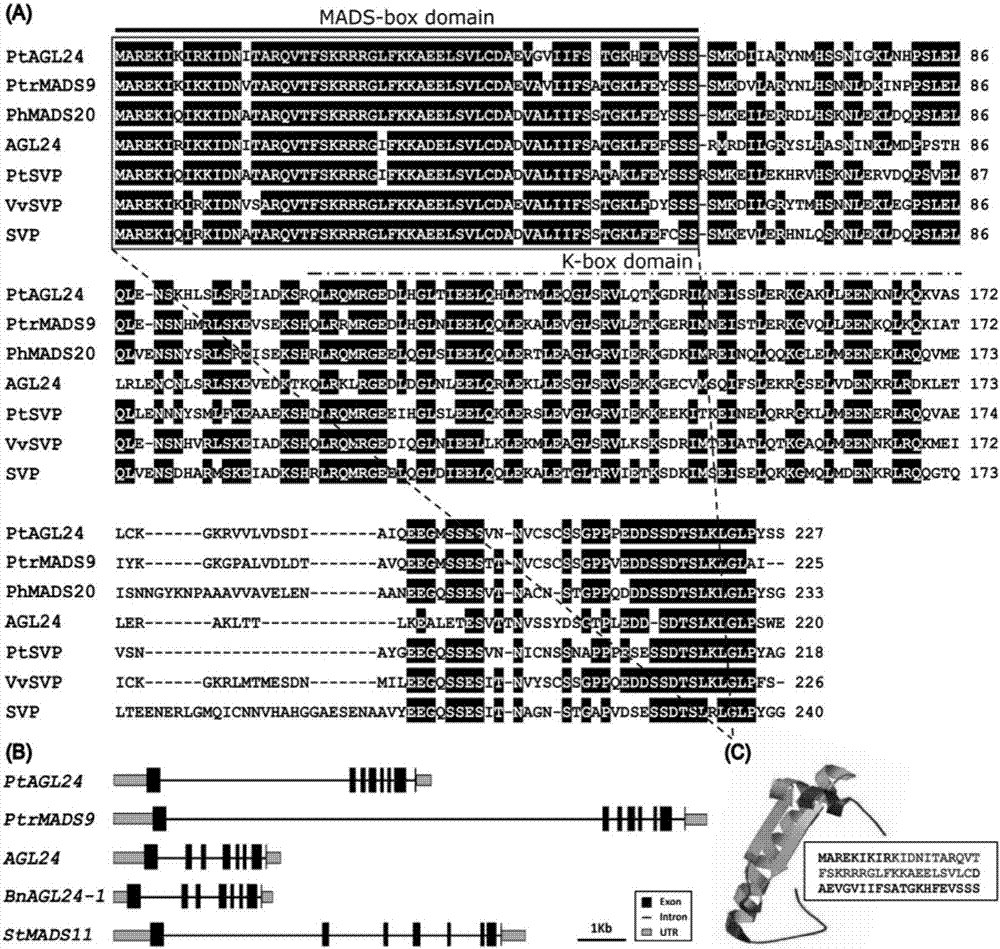Precocious trifoliate orange PtAGL24 gene separation and application with effect of regulating and controlling plant early blossoming
A technology of AGL24 and ptagl24, which is applied in the field of separation and application of PtAGL24 gene of Aurantium japonica to achieve the effects of shortening flowering time and shortening childhood
- Summary
- Abstract
- Description
- Claims
- Application Information
AI Technical Summary
Problems solved by technology
Method used
Image
Examples
Embodiment 1
[0038] Example 1 Isolation and sequence analysis of PtAGL24 gene
[0039] In order to obtain the homologous gene of AGL24 in citrus, this embodiment utilizes the CDS sequence of Arabidopsis AGL24 gene (Gene ID is AT4G24540) in the sweet orange database (https: / / phytozome.jgi.doe.gov / pz / portal. html#!info?alias=Org_Csinensis) to perform a Blast search, and the sequence with the highest homology obtained is the nucleotide sequence of the AGL24 gene (Gene ID is orange1.1g027190m) in citrus, and the Primer 5.0 software is used to design primers according to the general In principle, primers were designed in the 5'-UTR region and 3'-UTR region of the gene to amplify the full-length cDNA sequence.
[0040] RNA was extracted and reverse-transcribed from Trifoliate trifoliate Fructus (taken from the herbarium of Huazhong Agricultural University, literature source: Liang Suiquan et al., 1999; Zhang et al.2011), and the obtained first-strand cDNA was used to amplify the PtAGL24 gene. f...
Embodiment 2
[0042] Example 2 Cloning and bioinformatics analysis of PtAGL24 promoter
[0043] Referring to the sweet orange genome, find out the upstream promoter sequence of the PtAGL24 gene, use the software Primer5.0 to design primers according to the general principles of primer design, and use the CTAB method to extract the genomic DNA of the leaves of Trifoliate trifoliate Fructus. The DNA extraction method refers to the method reported by Cheng Yunjiang (Cheng et al. 2003). Using this DNA as a template, high-fidelity Taq enzyme was used to amplify the promoter. The sequence of the primer pair used to amplify the PtAGL24 promoter is as follows:
[0044] Forward primer: 5'‐GATAAGATAAATCGGAAAT‐3'
[0045] Reverse primer: 5'‐AATAATATATAATAAGCAGA‐3'
[0046] The amplified promoter fragment was detected by electrophoresis on 1% agarose gel, and the target fragment was recovered and purified according to the operation manual of the agarose gel recovery kit (purchased from Shanghai Jieru...
Embodiment 3
[0050] Example 3 Subcellular localization of PtAGL24 protein
[0051](1) Vector preparation: It was predicted that PtAGL24 protein might be localized in the nucleus by using the PSORT program. In order to verify this prediction result, a vector fused with the coding sequence of PtAGL24 and GFP protein was constructed. According to the multiple cloning site and the PtAGL24 sequence of the pCAMBIA1302 vector (purchased from the CAMBIA laboratory in Australia), use Primer Premier 5.0 software to design the primers for amplifying PtAGL24 according to the principle of general design primers. The Nco I restriction site was added to the 'end respectively (see Table 3). The primer sequences are:
[0052] Forward primer: 5'‐ccatggGGCTTTAGGTTACTGTGATC‐3';
[0053] Reverse primer: 5'‐ccatggGCTGGAGTAGGGAAGCCCTA‐3' (Note: lowercase letters are the added restriction sites).
[0054] PtAGL24 was amplified using the bacterial solution of PtAGL24 and pMD18-T (purchased from Treasure Bioengi...
PUM
 Login to View More
Login to View More Abstract
Description
Claims
Application Information
 Login to View More
Login to View More - R&D
- Intellectual Property
- Life Sciences
- Materials
- Tech Scout
- Unparalleled Data Quality
- Higher Quality Content
- 60% Fewer Hallucinations
Browse by: Latest US Patents, China's latest patents, Technical Efficacy Thesaurus, Application Domain, Technology Topic, Popular Technical Reports.
© 2025 PatSnap. All rights reserved.Legal|Privacy policy|Modern Slavery Act Transparency Statement|Sitemap|About US| Contact US: help@patsnap.com



